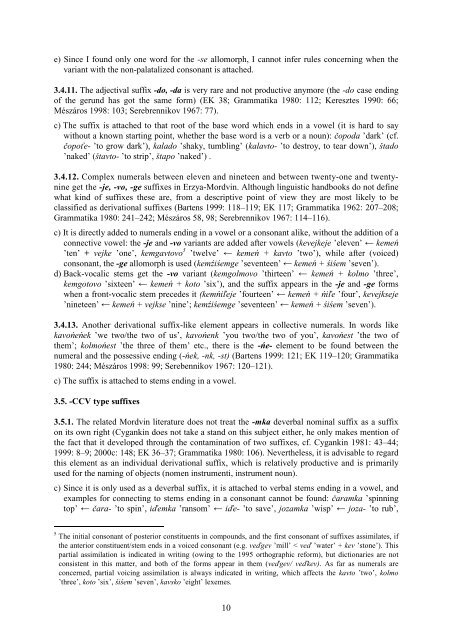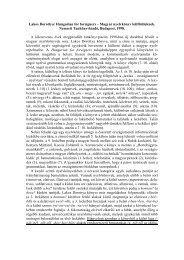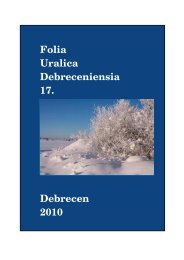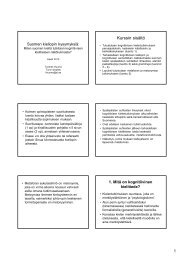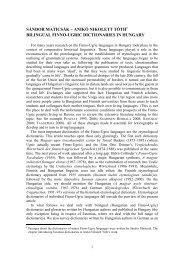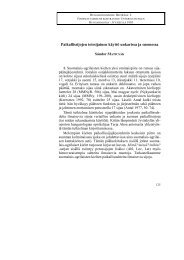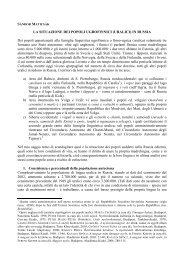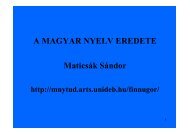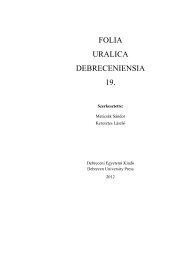Allomorphic variants of Erzya-Mordvin nominal derivational suffixes
Allomorphic variants of Erzya-Mordvin nominal derivational suffixes
Allomorphic variants of Erzya-Mordvin nominal derivational suffixes
Create successful ePaper yourself
Turn your PDF publications into a flip-book with our unique Google optimized e-Paper software.
e) Since I found only one word for the -se allomorph, I cannot infer rules concerning when thevariant with the non-palatalized consonant is attached.3.4.11. The adjectival suffix -do, -da is very rare and not productive anymore (the -do case ending<strong>of</strong> the gerund has got the same form) (EK 38; Grammatika 1980: 112; Keresztes 1990: 66;Mészáros 1998: 103; Serebrennikov 1967: 77).c) The suffix is attached to that root <strong>of</strong> the base word which ends in a vowel (it is hard to saywithout a known starting point, whether the base word is a verb or a noun): čopoda ’dark’ (cf.čopoťe- ’to grow dark’), kalado ’shaky, tumbling’ (kalavto- ’to destroy, to tear down’), štado’naked’ (štavto- ’to strip’, štapo ’naked’) .3.4.12. Complex numerals between eleven and nineteen and between twenty-one and twentynineget the -je, -vo, -ge <strong>suffixes</strong> in <strong>Erzya</strong>-<strong>Mordvin</strong>. Although linguistic handbooks do not definewhat kind <strong>of</strong> <strong>suffixes</strong> these are, from a descriptive point <strong>of</strong> view they are most likely to beclassified as <strong>derivational</strong> <strong>suffixes</strong> (Bartens 1999: 118–119; EK 117; Grammatika 1962: 207–208;Grammatika 1980: 241–242; Mészáros 58, 98; Serebrennikov 1967: 114–116).c) It is directly added to numerals ending in a vowel or a consonant alike, without the addition <strong>of</strong> aconnective vowel: the -je and -vo <strong>variants</strong> are added after vowels (kevejkeje ’eleven’ ← kemeń’ten’ + vejke ’one’, kemgavtovo 5 ’twelve’ ← kemeń + kavto ’two’), while after (voiced)consonant, the -ge allomorph is used (kemźiśemge ’seventeen’ ← kemeń + śiśem ’seven’).d) Back-vocalic stems get the -vo variant (kemgolmovo ’thirteen’ ← kemeń + kolmo ’three’,kemgotovo ’sixteen’ ← kemeń + koto ’six’), and the suffix appears in the -je and -ge formswhen a front-vocalic stem precedes it (kemńiľeje ’fourteen’ ← kemeń + ńiľe ’four’, kevejkseje’nineteen’ ← kemeń + vejkse ’nine’; kemźiśemge ’seventeen’ ← kemeń + śiśem ’seven’).3.4.13. Another <strong>derivational</strong> suffix-like element appears in collective numerals. In words likekavońeńek ’we two/the two <strong>of</strong> us’, kavońenk ’you two/the two <strong>of</strong> you’, kavońest ’the two <strong>of</strong>them’; kolmońest ’the three <strong>of</strong> them’ etc., there is the -ńe- element to be found between thenumeral and the possessive ending (-ńek, -nk, -st) (Bartens 1999: 121; EK 119–120; Grammatika1980: 244; Mészáros 1998: 99; Serebennikov 1967: 120–121).c) The suffix is attached to stems ending in a vowel.3.5. -CCV type <strong>suffixes</strong>3.5.1. The related <strong>Mordvin</strong> literature does not treat the -mka deverbal <strong>nominal</strong> suffix as a suffixon its own right (Cygankin does not take a stand on this subject either, he only makes mention <strong>of</strong>the fact that it developed through the contamination <strong>of</strong> two <strong>suffixes</strong>, cf. Cygankin 1981: 43–44;1999: 8–9; 2000c: 148; EK 36–37; Grammatika 1980: 106). Nevertheless, it is advisable to regardthis element as an individual <strong>derivational</strong> suffix, which is relatively productive and is primarilyused for the naming <strong>of</strong> objects (nomen instrumenti, instrument noun).c) Since it is only used as a deverbal suffix, it is attached to verbal stems ending in a vowel, andexamples for connecting to stems ending in a consonant cannot be found: čaramka ’spinningtop’ ← čara- ’to spin’, iďemka ’ransom’ ← iďe- ’to save’, jozamka ’wisp’ ← joza- ’to rub’,5 The initial consonant <strong>of</strong> posterior constituents in compounds, and the first consonant <strong>of</strong> <strong>suffixes</strong> assimilates, ifthe anterior constituent/stem ends in a voiced consonant (e.g. veďgev ’mill’ < veď ’water’ + kev ’stone’). Thispartial assimilation is indicated in writing (owing to the 1995 orthographic reform), but dictionaries are notconsistent in this matter, and both <strong>of</strong> the forms appear in them (veďgev/ veďkev). As far as numerals areconcerned, partial voicing assimilation is always indicated in writing, which affects the kavto ’two’, kolmo’three’, koto ’six’, śiśem ’seven’, kavsko ’eight’ lexemes.10


